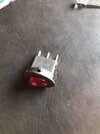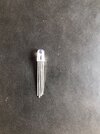Hello, first time on a Electronics Forum, hope I can get some help..
Any direct answers or links to where I can learn note about his (PDF, YouTube, free/paid course) are highly appreciated!
I am trying to create lighting systems for the lamps I make. Want to incorporate:
-RGB LEDs
-Rechargeable Lithium battery
-USB-C connector
-Voltage regulator (dimmer)
-On / Off switch
This is the progress I've made and where I'm getting stuck:
}} Lamp, Base/Housing {{
Photo:

I will enclose all electronics inside 2 engraved wood planks and leave the usb-C entrance flush to the side.
}} Circuit, Battery & Output {{
Photo:

I connect it this way and after a while the chip LED marked the change from empty battery to fully charged.
What is NOT working is the Output, when I connect my RBG to the chip output or directly to the positive and negative from the battery it won't light up.
>>This is where I am stuck<< ^^^^
I tested the RBG directly on a 9v - 1amp power supply and it worked well (with resistor).
}} End result I would want to get to {{
Photo:


Hope this drawing explains well enough.
Here I have several questions:
How to connect batteries in parallel effectively (so I dont charge one battery with the charge of another)
How to connect RGB in parallel (when I try to connect several LED, some are brighter than others or make others turn off)
How do I get to know the specs of my RGB? (I didn't buy these myself, but I would like to know how much voltage & amperage each LED take)
How do I use a voltage regulator as a dimmer or at all?
(It has 3 pins with no indication of input, output)
[I want to be able to change the voltage of Red, Green or Blue to change what general color I get like white, purple, cyan, orange]
Why does my on/off switch have 3 pins?
(How do I know what each one is for?)
Thank you all for the help & attention!
Any direct answers or links to where I can learn note about his (PDF, YouTube, free/paid course) are highly appreciated!
I am trying to create lighting systems for the lamps I make. Want to incorporate:
-RGB LEDs
-Rechargeable Lithium battery
-USB-C connector
-Voltage regulator (dimmer)
-On / Off switch
This is the progress I've made and where I'm getting stuck:
}} Lamp, Base/Housing {{
Photo:
I will enclose all electronics inside 2 engraved wood planks and leave the usb-C entrance flush to the side.
}} Circuit, Battery & Output {{
Photo:
I connect it this way and after a while the chip LED marked the change from empty battery to fully charged.
What is NOT working is the Output, when I connect my RBG to the chip output or directly to the positive and negative from the battery it won't light up.
>>This is where I am stuck<< ^^^^
I tested the RBG directly on a 9v - 1amp power supply and it worked well (with resistor).
}} End result I would want to get to {{
Photo:
Hope this drawing explains well enough.
Here I have several questions:
How to connect batteries in parallel effectively (so I dont charge one battery with the charge of another)
How to connect RGB in parallel (when I try to connect several LED, some are brighter than others or make others turn off)
How do I get to know the specs of my RGB? (I didn't buy these myself, but I would like to know how much voltage & amperage each LED take)
How do I use a voltage regulator as a dimmer or at all?
(It has 3 pins with no indication of input, output)
[I want to be able to change the voltage of Red, Green or Blue to change what general color I get like white, purple, cyan, orange]
Why does my on/off switch have 3 pins?
(How do I know what each one is for?)
Thank you all for the help & attention!





